Stepintime (talk | contribs) |
m (→As a general inspiration: rogue) |
||
| Line 182: | Line 182: | ||
Outside their niches Alaskan Indians have a large impact on mainstream Alaskan culture. Ideas of |
Outside their niches Alaskan Indians have a large impact on mainstream Alaskan culture. Ideas of |
||
| − | Alaska's Indians being noble spiritual warriors and unfortunate victims have descended from the 19th century concept of the "Noble Savage. In modern times Alaksa's Indians have been often been reduced to positive caricatures or generalized with other ethnic groups. ''New Bullets ''(1969) portrayed the Ute People as helpful - almost playful accomplices - for the |
+ | Alaska's Indians being noble spiritual warriors and unfortunate victims have descended from the 19th century concept of the "Noble Savage. In modern times Alaksa's Indians have been often been reduced to positive caricatures or generalized with other ethnic groups. ''New Bullets ''(1969) portrayed the Ute People as helpful - almost playful accomplices - for the Rogue Cossack protagonist, the protagonist's promiscuous Ute Lover was played by an Asian Alaskan actress. |
During the Cold War movies and music used Indians to distinguish Alaska as a North American country in contrast to the Eurasia the Soviet Union. While it has been perceived by Alaskans that the natives of Russian Asia were abused by the Soviet State, Alaska's Indians were hoped to be included within the state as part of the country's liberal direction. In the 21st century efforts have been made by Alaska's creative community to portray them in a more realistic and dynamic light. The recent blockbuster film ''Flaming Arrow ''featured the traditional cast conflict within the tribes from a perspective of a Russian Old Believer in the colonial period. |
During the Cold War movies and music used Indians to distinguish Alaska as a North American country in contrast to the Eurasia the Soviet Union. While it has been perceived by Alaskans that the natives of Russian Asia were abused by the Soviet State, Alaska's Indians were hoped to be included within the state as part of the country's liberal direction. In the 21st century efforts have been made by Alaska's creative community to portray them in a more realistic and dynamic light. The recent blockbuster film ''Flaming Arrow ''featured the traditional cast conflict within the tribes from a perspective of a Russian Old Believer in the colonial period. |
||
| − | In daily life traces of Indians are found everywhere, in totem style cups, Indian styled furniture on the newest models, and many Aleut names given to consumer products, motor vehicles and ideas. Similar to the U.S military, many weapons in the Alaskan Armed Forces have been named in honor of the Indians. Recently nuances such as traditional Tlingit greetings and rituals have been adopted by some admiring Slavic Alaskans. Traces of Indians in mainstream culture is most prevalent in the current environmentalist movement of Alaska incorporating traditional veneration of animals and natural forces into their image. |
+ | In daily life traces of Indians are found everywhere, in totem style cups, Indian styled furniture on the newest models, and many Aleut names given to consumer products, motor vehicles and ideas. Similar to the U.S military, many weapons in the Alaskan Armed Forces have been named in honor of the Indians. Recently nuances such as traditional Tlingit greetings and rituals have been adopted by some admiring Slavic Alaskans. Traces of Indians in mainstream culture is most prevalent in the current environmentalist movement of Alaska incorporating traditional veneration of animals and natural forces into their image. |
== Current Issues == |
== Current Issues == |
||
Revision as of 20:04, 24 April 2019
| The following Russian America page is under construction.
Please do not edit or alter this article in any way while this template is active. All unauthorized edits may be reverted on the admin's discretion. Propose any changes to the talk page. |
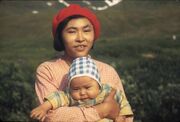
An Aleut mother and child (1941).
Alaskan Indians (Russian: аляскинские индейцы, alyaskinskiye indeytsy) are the indigenous peoples of Alaska. The first Alaskan Indians migrated from Asia around 18,000 years ago when Asia and North America were connected by a land bridge. Alaskan Indians currently form the largest group in two governorates — Aleutia and the Far North. The Alaskan federal government formally recognizes over 50 tribes.
According to the 2007 Census, roughly 2.5% of the population identified as Alaskan Indians, with most Alaskans of Asian and European descent having some native heritage.
Etymology
Alaska formally uses the term Alaskan Indian in reference to all indigenous groups. The Russian use of the name "Indian" was borrowed from the United States, which itself was coined by Christopher Columbus (who mistook the Americas for India). In the Russian language, the name is indeyets (индеец). It should be noted that this name is grammatically distinct from the name used to denote those from India — indiyets (индиец).
Prior to Alaska's independence, the Russian Empire colloquially recognized three native groups: Aleuts, Eskimos, and Indians. This distinction was attributed to Russia's early contact with the native people of the Bering Sea (who were lumped together with Siberians). Contact with the native peoples of the Alexander Archipelago (and beyond) would not take place until the late 18th Century. This ethnographic distinction remains in partial use to this day.
Presently there is a movement from Indians and Academics for official records to change terms to simply "original nations" or "aborigines" but this has not occurred. Opposition to a possible new name for Alaskan Indians say this would rob of Alaskan Indians of their identity as the natives of Alaska despite Indian statements to the contrary.
Classification
Alaska's Indians are diverse in dozens of language families and Ethnic groups. For purposes of anthropology and historiography they are commonly put into five cultural zones by Alaskan and Russian experts.
Arctic & Aleutian (Inuipat, Alutiiq, Qwaiaraq, Aleut, Yupik)
Interior Athabaskan (Na'dene)
Maritime Temperate (Tlingit, Haida, Shimashan)
Sonoman Chaparral (Pomo, Shasta, Wintun)
History
Early Contact
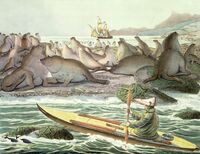
First encounter between Russians and Aleut Fishermen, 1741
Upon the first contact between Russians and Alaskan Indians in 1741 there would have at least a half-million people in the whole territory that is now Alaska. Societies and economies varied greatly between the different native tribes. However, they were all remarkable for their reluctance to use agriculture compared to natives in Mexico and the Eastern United States. Fishing was the most common activity in many tribes with landlocked natives relying on hunter gathering. Tribes farther south tended to have more complex rituals and society due to having more resources, throughout the country there was generally as system of coastal natives dominating interior peoples.
Epidemics killed many natives in almost all contacts between Russians and Indians. Relations between Russians and natives varied between violence and cooperation, native Tlingit people almost drove Russians away in 1804.In The first forty years of actual colonization (1780-1820) Russians were reliant upon native peoples, particularly Aleuts as a colonial work force. Until the Russo-Spanish war many natives in the territory claimed by Russia were unknown to Europeans.
Cooperation
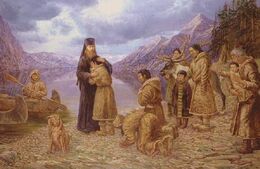
St. Tikhon, bidding farewell to Athabaskans
As larger scale Russian settlement of Alaska began after 1810 relations between Indians and colonists varied greatly between different areas of Russian Alaska. Southern Alaskan territories in Oregon and Sonoma enjoyed peaceful coexistence and cohabitation but there was war in territories father north.
In early Fort Ross, Elizabeth Kuskova, wife of Russian American Company administrator Ivan Kuskova bridged the colony with the Pomo people. Elizabeth taught herself the Pomo language and became the chief translator between the natives and the colonists. Often visiting Pomo villages she learned about the land and what could be grown contributing to the success of Fort Ross as a breadbasket. Elizabeth came to admire the native peoples for their cohabitation with the natural world and encouraged good treatment of the Pomo by her husband's associates. She founded a Russian Orthodox School that exists into the present.
The onset of war with Spain sparked tensions between the settlers and Chaparral Indians as incoming soldiers did not respect earlier treaties, often stealing food and supplies for the war effort. After the war, the increasingly pressured Pomo had to assimilate into colonial society, many taking on Russian names and customs. Other Pomo however, resisted and fled into the Rocky Mountains. In 1831 on orders of the administrator of the Russian American Company a plot of reserved land for the Pomo was granted to be accompanied by secular advisers and Orthodox priests. While more open to ethnic Europeans today the reserved land continues to hold autonomous status within the governate of Sonoma.
The Great Tlingit War
| |||||||||||||||||||||||||||||||||||||||
Despite insistence by several czars for good treatment of native peoples there were several outbreaks of violence in North Alaska. The Tlingit, as the traditional center of power in the region, were the most resistant to colonization. Even after 1804 eviction of Tlingit from New Archangel the Russian colonies in Tongass and Yakut were always on the the defensive from annual attacks from the prosperous Tlingit.
Reluctant to station a permanent garrison of regular soldiers the overextended Russian Empire sent a troupe of Cossacks to subjugate Indian raiders in 1825. What was expected to be a short term conflict in style the quick suppression of natives in Siberia became a conflict that persisted for thirty years. Against Europeans the Tlingit used night attacks, bronze weapons and rifles bought from British traders. The Tlingit learned how to fight on horseback against the settlers. Short summers and Russian ignorance of the terrain gave the Tlingit the upper hand. Yet, as the war continued the Tlingit were disrupted by revolting Indian tribes which had been subordinate for thousands of years.
Many Athabaskan peoples saw Russian colonization as a way to escape traditional Tlingit domination, Missions from the Russian Orthodox Church produced the first settlements of Alaska's interior. The presence of the missions and Russian priests turned the conflict into a religious war resulting in infamous massacres from both sides. The continuance and cost of of the war led to the empire directly appropriating control of the colonies from the Russian American Company.
Blood Fields
Eventually Russian settlers seized control of major rivers including the Chilkat to deprive Tlingit of their traditional fishing stocks.
In September 11th 1856 the battle of Blood Fields (Russian: Поля крови, Polya Krovi) resulted in a tactical stalemate but strategic Russian victory.
For the Tlingit Confederation the goal of the battle was to overwhelm Russian lines, so that the frontier villages southward could be ransacked for supplies imported from Sonoma. Without grain the Tlingit could not continue to use their horses in the war. The Russians had the mistaken belief that the Tlingit could not fight in open space and would easily be shot down.
The Tlingit began with a cavalry offensive to isolate The Cossacks from the other parts of the colonial forces. The Tlingit fired arrows and guns in a Cantabrian circle picking off Cossacks provoking them into a charge.
All of the Tlingit assaulted the Russian Center which consisted of Athabaskans and Pioneers in a great instance of hand to hand combat. European Soldiers broke into a rout as they were unused to native warfare. Athabaskans and Old Believers were more motivated fighting in what had become their own landscape
In the confused fighting the Cossacks regrouped and pinned Tlingit warriors from many directions driving them back to their original position. Both sides retired for the night. For three more days both sides remained firm before they withdrawing as the climate became colder. The Tlingit stole some food supplies from the colonists but not enough to survive the entire winter. In a bid of desperation Tlingit agents kidnapped the daughter of the imperial governor.
Months later, with the prospect of famine the Tlingit Confederation in Sitka gave a conditional surrender to the Russian American Krai where they converted to Christianity but received immunizations for small pox and tribal autonomy in return. The daughter was returned peacefully and without ransom.
Under Imperial Authorities
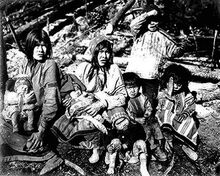
Tlingit family, late 19th century
After 1860 the colonists came to impose their way of life on all Indians residing within the territory that is today Alaska. For Indians life varied greatly depending on which tribe they were a part. By comparison some Alaskan natives fared much better than the indigenous people of Siberia but others fared worse.
The colonial authorities enforced a system of casts between tribes. Those such as the Aleuts were semi Russianized and began to cluster in neighborhoods of port such cities such as New Arkhangelsk, leading to the birth of a unique creole languages spoken today. Urban life provided new opportunities for Indians most favored by the colonial government, many found work as carpenters, cooks and shopkeepers. During the reign of Czar Alexander II the first modern Alaskan literature was produced from Indian communities in Ross and New Archangel. Better off Alaskan Indians began to visit the Russian mother country. Alaskan Indians served as an inspiration to the great Russian writers as as Leo Tolstoy who called Indians "renewed virgin people".
In Southern Alaska native Alaskans had to choose to live in the multicultural Somona reserve, or to integrate with settler populations in various settings The populations of native Alaskans which had already been decimated by colonization only began to recover in the late 19th century. Pomo men would be prohibited from marrying European women until Alaskan Reunification.
The 1860's were a turning point for the Indian tribes which had not yet been encountered by any Europeans. Pioneers who ventured to Arctic Coast and the Rocky Mountains were the first to meet Inuits and other remote Indian peoples. Initially Pioneers often stayed only temporarily, sometimes abducting native women. Pioneers were followed by government teams of surveyors and Cossacks to map out the extent of Russian American lands. Like others Indians Inuits and Mountain Peoples were subject to terrible epidemics. Because the lands were inhospitable to Europeans the Inuit and Yukon Indians retained their way of life through the late 20th century.
Tribes who had violently resisted colonization fared the worst, originally placed on reservations, their lands would shrink as gold rush pioneers continued to seize their land. Though officially under the czar's protection, Tlingit and other "hostiles" were ruled by Cossacks who regularly abused their power. Alcoholism and undernourishment was the norm until the late 20th century. Being otherwise left alone save for Cossack raids or tax collection Tlingit kept their original culture, while being subjugated. A new genre of song bol (Russian:боль) using strong high pitch and low pitch sounds to convey their pain, an enhancement of traditional music based from throat singing.
The New Alaskan Indians
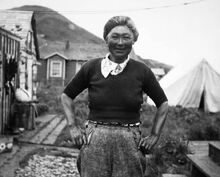
Aleut woman, working for the Russian American Company, 1900
By 1900, Alaskan Indians already diverse by their heritage, were even more divided based on their class and their location. Ranging from living Russianized middle class lives, to those untouched by modern life. The only common thread being their pre-colonial ancestry.
The Russian-Japanese war was the first unified Alaskan experience for Alaskan Indians, conscription agents looked to Alaskan Indians to fulfill their quotas, Alaskan Indians fought in colonial corps with all other groups from Russian America. However biases existed by branch, Aleut were consistently drafted into the navy regardless of their occupation. "Mountain Tribes" such as the Yukon Tlingit were consistently drafted into the army. Returning home Alaskan Indian veterans regardless of tribal origin began to take a larger role in public life, as activists, singers and technicians. Five Alaskan Indians took seats in the first Alaskan Duma, but held no real power.
Prior to WWI, support for the Nasha America independence movement was varied, urban upper-class Indians tended to oppose the movement, fearing that without colonial control they would be subject to violence from the white population. Indians, working in industrial occupations tended to view the movement with apathy. Those living outside of European towns, in reservations or other communities showed interest, if such independence would remove governmental and European influence from their lives.
Upon the beginning of WWI, Indian men were again conscripted, on average the casualty ratio for Alaskan Indians were even higher than the rates for Slavic citizens. The pressure of a European war that bore no practical significance to Indians quickly turned the majority of Alaskan Indians against imperial authorities.
Alaskan Wars
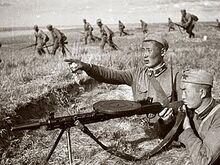
Yupik soldiers of the Alaskan Socialist Republic fighting border skirmishes 1941,
The declaration of independent Alaska was met with both caution and enthusiasm by Indians tribes which had traditionally cooperated with authorities were targeted by white populations in race riots. In the countryside tribes split on which faction to support in the ensuing wars. Yukon natives took the opportunity to revolt and establish sovereignty as a de facto independent state. 20,000 Indians died between 1917 and 1941 in the brutal conflicts, most deaths were a result of famine or localized violence. The vast movements and diasporas of tribal cultures outside their traditional lands permanently redefined the identity of Alaska's Indians.
Indians in the Alaskan Socialist Republic
The Alaskan Socialist Republic promised "full equality" for all peoples to abolish class and racial warfare, with mixed results. Indians fought side-by-side with white Slavs, in the integrated Alaskan Red Army. In peace the Alaskan Communist Party provided avenues for Indians to rise and hold positions of power. The state brought official status to the Aleut and Inuit languages in name, though actual usage was discouraged in favor of Ninchik Russian. The forced equality based on Marxist racial concepts eroded tribal and familial identity. Shamans were particularly targeted by the regime. Traditional symbols and society of native life were dealt total destruction, and never resurrected within the modern lands of the Shielkov Governate. Inuits were disturbed by attempts to collectivize caribou herding causing many to emigrate eastward towards Yukon and Borealia. Inuits who stayed in the A.S.R migrated toward white towns or faced famine.
In the Alaskan Democratic Republic
Across the Alaskan Range Indians were caught in the ongoing war between the Alaskan Socialist Republic and the right wing New Archangel government. Cossacks ruthlessly subjugated rural native populations driving many tribes north towards free Yukon. Urban Aleuts despite being supporters of the old regime were viewed with distrust and faced segregation. Other peoples such as the Haida were subject to violence by street mobs.
In the Commonwealth of Colombia .
Southwards the Anglo supremacist Colombian government gave Indians in their territories the choice between renunciation of the Russian Orthodox Church and expulsion. Those who remained were subject to segregation and race riots from the English people, infamously a group of 14 Shimashan were lynched after being accused of "terrorism against the legitimate community". Federal Alaskan demands for better treatment of Indians caused Colombian resistance to a reunified Alaska.
In the United Republic of Oregon
While Oregon was comparatively kinder to Indians than other states the arrival of refugees from Colombia and the violent Northern governates created an atmosphere of tensions between Whites, and the preexisting Indian population. Unable to create a solution for fleeing people, Indians were permitted to remain but treated with disregard and neglect. Some refugee Indians founded towns that still exist into the present. Occasional outbursts of White-Indian violence came from competition over sparse employment in the area.
in the Peoples Republic of Sonoma
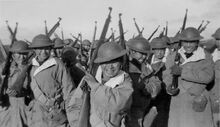
A multi tribal conscript regiment posing in the early Alaskan republic, 1935.
In Sonoma, the democratic-socialist government attempted to integrate native tribes into mainstream Slavic culture. Under the law Indians were given full rights as citizens, in practice however exclusion and discrimination remained at the hands of white individuals as well as forced cultural assimilation. In this era many natives formed the core for later movements, including the young writer Petor Kalifornskiy who emigrated from New Archangel to Ross in the 1930s.
In East Yukon
The lands of the former Yukon Oblast from Russian America were unique in having an Indian majority population at the time, while never organized into a single government the isolated Indian communities joined together to fight off invasions from the S.A.R and the D.R.N.R. While the arctic coast and West Yukon were overrun, Eastern Yukon remained free. Indians governed themselves in councils that resembled the precolonial past and lived along side the white Ukrainian Alaskan minority for common interest. The independence of the Indian Yukoniers - prevailed until the emergence of the United Republic. The experience of free Indian Yukoniers are remembered as a beacon of hope for Indians, an exception to the whole scale destruction and assimilation throughout the country that occurred in the divided time.
Renaissance in the United Republic
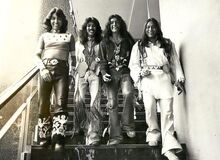
Alaskan Indian rock band in the late 20th century, 1970
The reunification of Alaska in 1942 set a new era for Alaskan Indians. Constitutionally all Indians for the first time were granted full citizenship and permission to travel freely throughout the country.The new republic sometimes forced regional governments which had mistreated Indian communities, particularly Shielkov and New Albion gave reparations to those who had been harmed. While hundreds of refugees did return home, many opted to stay in the affluent coastal areas they had migrated to. In the first National Alaskan Duma, two Indians were set aside to be deputies.
Problems and echos from the war continued to persist in many cases those Indians who had held modern homes or held land before the laws returned to see it occupied by Europeans. The reparations assured most Indians were rewarded back loss but this process took until 1964 in many cases. Individual governates made their own new laws to restrict political and economic opportunities. Violence between Indians and Cossacks out of old war grudges occurred throughout the 1950's killing dozens on both sides. The Aleutian break way from the Shielkov without their permission was a high water mark in White-Indian tensions. The national government accepted the breakaway to take place as a strike against communism,
Many Aleutian families were split by the fall of the A.S.R and the ongoing Cold War as many had willingly or unwillingly gone to Soviet Territories in the Catherine Archipelago and Siberia. Relatives on average remained divided more years than the Slavic families because Indians tended to live in sensitive military locations around the Bering Sea. Some would not see their siblings, parents or children until 1991.
In the first decades of the reunified republic many Indians were stuck in poverty both due to discrimination and lack of modern education, even while some Indian individuals became major public figures. Some wealthier Indians took the opportunity to lead activism for their less well off kindred, however conservative Indians worked with white authorities against reparations and grants for rival tribes. The idea of a United Alaskan Indian Community was piecemeal at best
Like the rest of the nation the 1960's were a transformation time, president Vasily Kardash implemented programs which specifically spoke to the ongoing needs of the Indian community. Special grants for higher education and a temporary program of affirmative action uplifted many from previously downtrodden groups. Some reservations were closed and replaced with town incorporation in an effort to incorporate Indians with the majority of the population.
The second half of the 20th century saw an improvement of living standards for all. By the 1980's a generation of college educated natives started businesses, private schools and bands.However, this came at the cost of environmental degradation and cultural identity. Towards the turn of the 21st century, Indians became involved in the wider green movement to protect ancestral lands, Indian activism was a major cause of the creation of new National Parks in the Far North. Demands for the protection of native languages led to introduction of new language classes and semi official status for Aleut, and Inuit. The election of Alaska's first Indian governor Boris Mallot of Yakutat in 2014 was a hopeful milestone in the 21st Century.
As a national minority Alaskan Indians are present everywhere, their past their traditions part of a new hope for the future. While Indians are still economically behind the general population progress continue to be made. Meanwhile traditional Indian culture and religion are exhibiting influence on the general society.
Culture
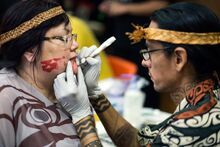
Tlingit Artist painting a traditional tattoo. Tattoos are a symbol of pride by Alaskan Indians who stick to their traditional culture.
On Reservations
Reservations continue to exist and have still developed in relative isolation since the reunification of the country. What has changed since the turn of the millennium has been a greater exposure of reservation subculture. Those on the reservation remain the most distinct of Alaska's Indians. This is true of the Tlingit and Inuit peoples especially.
Traditional family customs of specific tribes still apply for reservations, this is an overt statement of independence, identifying their families most strongly through their mother, and acknowledging mother as the head of household. This has been prized by Alaska's Feminist movement as being an example of natural equality between men and women.
Reservation subculture extends to apparel, tattoos, music and television. often wearing homemade clothes or updated versions of traditional clothes. Tlingit style tattoos have become famous for their wild choices of design, but while reservations have attempted to restrict such art to their own people by copyrighting such work as "traditional heritage" nonetheless they have been copied widely by outside artists.
Music and Television originally meant to bind Reservation People together is also reaching outsiders. Reservation Boi Throat Singing experimented with strange harmonies not seen anywhere else in the world. Over time in the 20th Century reservation music came under subtle influence by other music genres, often using guitars and base drums to create a psychedelic feel.
Creoles

Eskimo Ice-Cream or Akutaq consists of meat and berries. Modified versions of this traditional food has become a popular desert dish in the majority of Alaskan diners.
The Creole population of historically Russianized and mixed Indians created the most dynamic ethnic enclaves in the late 19th/ early 20th century. Today pockets of these enclaves continue to exist in the largest cities, the Indian Trails (Russian :трассы, Индийские, Indiyskiye trassy) are best seen in Ross and New Archangel. These neighborhoods continue to be a center of preservation for traditional heritage while being hot-spots of creativity.
Religiously, most Creoles are members of Indian majority congregations within the Alaskan Orthodox Church, while adopting white the church's customs wholesale they have also influenced the church. Ancestor spirits, and the Aurora Borealis phenomenon have been accepted by the Church as being Christian angels.
During the imperial period, Christian Aleuts were given acceptance by authorities to start their own enterprises primarily in fishing, service and in timber. The Creoles are best known for innovating their traditional foods to be palatable to the white population. Smoked Salmon Bites, Eskimo Ice Cream, Spicy Tea and Root Soup were invented in the imperial period but became popular as casual food in the United Republic. Today there is now a divide between traditional creole businesses and large European owned restaurant franchises that take take advantage of Indian cuisine.
In literature and theater Creoles at first adopted their own stories to Russian language and style. Creation stories for example would often insert Christian references, or even to European folk heroes as well native characters in spirits. Later stories about the anxiety of assimilating Indians, would win sympathy from liberal Russians. The traditional Indian use of body language in telling stories set the stage for the founding of theaters giving unique performances.
Up to the present, Creole is likely the largest culture that all Alaskan people have been exposed to. Creoles have often been accused of appropriating traditions for their own gain, however without Creoles much knowledge on customs and habits from precolonial times may had been forgotten entirely.
As a general inspiration
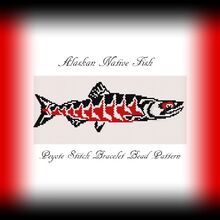
Symbols of traditional native Alaskan lifestyle such as this Salmon have become mainstream icons associated with Alaska's identity. Many Alaskan Artists have created their own interpretations of traditional culture.
Outside their niches Alaskan Indians have a large impact on mainstream Alaskan culture. Ideas of
Alaska's Indians being noble spiritual warriors and unfortunate victims have descended from the 19th century concept of the "Noble Savage. In modern times Alaksa's Indians have been often been reduced to positive caricatures or generalized with other ethnic groups. New Bullets (1969) portrayed the Ute People as helpful - almost playful accomplices - for the Rogue Cossack protagonist, the protagonist's promiscuous Ute Lover was played by an Asian Alaskan actress.
During the Cold War movies and music used Indians to distinguish Alaska as a North American country in contrast to the Eurasia the Soviet Union. While it has been perceived by Alaskans that the natives of Russian Asia were abused by the Soviet State, Alaska's Indians were hoped to be included within the state as part of the country's liberal direction. In the 21st century efforts have been made by Alaska's creative community to portray them in a more realistic and dynamic light. The recent blockbuster film Flaming Arrow featured the traditional cast conflict within the tribes from a perspective of a Russian Old Believer in the colonial period.
In daily life traces of Indians are found everywhere, in totem style cups, Indian styled furniture on the newest models, and many Aleut names given to consumer products, motor vehicles and ideas. Similar to the U.S military, many weapons in the Alaskan Armed Forces have been named in honor of the Indians. Recently nuances such as traditional Tlingit greetings and rituals have been adopted by some admiring Slavic Alaskans. Traces of Indians in mainstream culture is most prevalent in the current environmentalist movement of Alaska incorporating traditional veneration of animals and natural forces into their image.
Current Issues
Current issues for Alaska's Indians continue to include alcoholism, higher unemployment, loss of identity, environmental degradation and legal conflicts with historic subcultures such as the Cossacks and the Dougs.
Legal Issues
Alaska's Indians were often denied or wait-listed for direct reparations following the damage of the colonial period and Alaskan Wars on their people. Since the 1990's a new push to achieve justice has gained momentum. Alaska's Indians also file large court cases on police violence, environmental issues and school curriculum.
One of the highest profile cases was the 2000 supreme court case of Tlingit v.s Yakuita. Tlingit and Haida tribes came together to sue the Yakut government and the Cossack holds in the area to reclaim lost land seized in the 19th and the 20th centuries from various actors. What started as an individual case of a Tlingit man wishing to reclaim property willed from his great grandmother ballooned as a push receive collective reparations in property and assets. Cossacks bitterly fought back accusing the Indians of using the past to steal their homes. Hundreds of demonstrators from both sides filled the central square of New Archangel. Indian Rights had become a partisan issue.
While many of the Indian claims were at least in theory legitimate in that others had seized historic Indian lands illegally. The Court declared that the majority of these offensives to had occurred before the lifetime of most those living. Only a few of the plaintiffs were first hand victims. The courts declared that seizing lands that were now part of the Cossack heritage would be solving a wrong with another wrong, especially in the case where the property was occupied by households. A controversial comprise was met where the existing landowners would retain the property but compensate the Indians for the accrued monetary value, the supreme court obliged Yakutat to compensate Indians if the landholders were unable to do so themselves.
Many Indians saw this decision as a landmark defeat for their cause, nevertheless the Tlingit Confederation used some of the funds to start new a profitable entertainment business.
Conservation
When it comes to environmental protection Native Alaskans are conflicted. While by in large Alaskan Indians have environmentalist sentiment many Indians- particularly Inuit's in the Far North are employed by major extraction companies. At the same time many such employees still have connections to their tribal nation.
Impact on Academia
For the purposes of justifying its imperialism over the area Imperial Russian Scholars set about connecting Alaskan Indians with Siberian Indigenous Peoples. Numerous racial theories were popular at the turn of the century which directly connected Alaskan Indians to various Turkic peoples such as the Yakut and Kamchancan peoples. While archaeology and paleontology supports the theory of Bering land bridge migration much of the early conclusions of Russian Anthropologists were hasty and unscientific. As much as possible Alaskan Indians were distinguished from other North American Indians. This was problematic especially with the dozens of tribes in Sonoma, and Idaho which bear greater relation to Native Americans of the United States.
Before the Russian Revolution there was an movement, to create a vast grouping roughly corresponding to the modern Russian Far East, and Alaska to call the land historic 'Beringia' and the natives 'Beringians'. Not to be confused with the modern Bering Governate. This was going to appear on Russian census as a racial classification. However the Russian Civil war erupted before the policy's implementation.
Demographics
Native Alaskans as a proportion of the national population crashed to their lowest levels in 1947 due to the destruction of the Alaskan Wars. Gradually population has recovered in the United Republic. If counting all citizens who claim full Native or Creole ancestry the proportion of Indians in Alaska has grown to 2.7% according to the 2017 census. Though over 20% of Alaskans also claimed to share Indian Ancestry, Slavs and Asians have an tendency to trace back origins to Indians. The vast majority of those who claim ancestry do not have connections to Tribal Organizations.
Demographics on the economic and political widely range by tribe. Overall Native Alaskans since 1980 have been supporters of the Peace and Freedom Party. Alaskan Indian's gross national capita per income is smaller than the national average but has been rising steadily since 1990.
People
- Pyotr Kalifornsky (October 12, 1911 – June 5, 1993) — Dena'ina ethnographer and writer. He was an influential voice for Indian rights and for Alaskan republicanism.
- Boris Molotov (April 6, 1943) — Tlingit businessman and current Governor of Yakutat. Native of Slavorossiysk, he is the first Indian governor in Alaskan history. Molotov campaigned for environmental protection and the expansion of healthcare services.
- Yelizaveta Peratrovich — (July 4, 1911 – December 1, 1958) — Tlingit civil rights activist and an advocate for the anti-discrimination amendment of 1945.
| |||||

